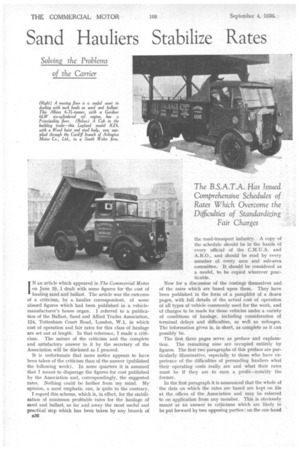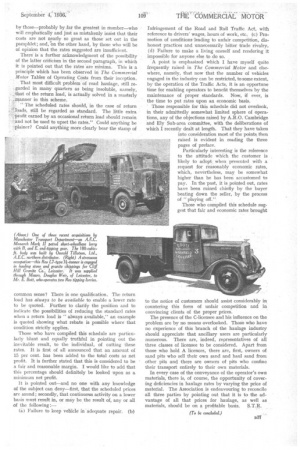Sand Hauliers Stabilize Rates
Page 50

Page 51

If you've noticed an error in this article please click here to report it so we can fix it.
IN an article which appeared in The Commercial Moto, on June 19, I dealt with some figures for the cost of hauling sand and ballast. The article was the outcome of a criticism, by a haulier correspondent, of some absurd figures which had been published in a vehiclemanufacturer's house organ. I referred to a publication of the Ballast, Sand and Allied Trades Association, 124, Tottenham Court Road, London, W.1, in which cost of operation and fair rates for this class of haulage are set out at length. In that reference, I made a criticism. The nature of the criticism and the complete and satisfactory answer to it by the secretary of the Association will be disclosed as I proceed.
It is unfortunate that more notice appears to have been taken of the criticism than of the answer (published the following week). In some quarters it is assumed that I meant to disparage the figures for cost published by the Association and, correspondingly, the suggested rates. Nothing could he farther from my mind. My opinion, a most emphatic one, is quite to the contrary.
I regard this scheme, which is, in effect, for the stabilization of minimum profitable rates for the haulage of sand and ballast, as far_ and away the most useful and practical step which has been taken by any branch of ES6 the road-transport industry. A copy of the schedule should be in the hands of every official of the C.M.U.A. and A.R.O., and should be read by every member of every area and sub-area committee. It should be considered as a model, to be copied wherever practicable.
Now for a discussion of the costings themselves and of the rates which are based upon them. They have been published in the form of a pamphlet of a dozen pages, with full details of the actual cost of operation of all types of vehicle commonly used for the work, and of charges to be made for those vehicles under a variety of conditions of haulage, including consideration of terminal delays and difficulties, as well as mileages. The information given is, in short, as complete as it can possibly be.
The fist three pages serve as preface and explanation. The remaining nine are occupied entirely by figures. The first two paragraphs of this preface are particularly illuminative, especially to those who have experience of the difficulties of persuading hauliers what their operating costs really are and what their rates must be if they are to earn a profit—notably the former.
In the first paragraph it is announced that the whole of the data on which the rates are based are kept on file at the offices of the Association and may be referred to on, application from any member. This is obviously meant as an answer to criticisms which are likely to be put forward by two opposing parties : on the one hand
by those—probably by far the greatest in riumber—who will emphatically and just as mistakenly insist that their costs are not nearly so great as those set out in the pamphlet ; and, On the other hand, by those who will be of opinion that the rates suggested are insufficient.
There is a further acknowledgment of the possibility of the latter criticism in the second paragraph, in which it is pointed out that the rates are minima. This is a principle which has been observed in The Commercial Motor Tables of Operating Costs from their inception.
That most difficult problem of road haulage, still regarded in many quarters as being insoluble, namely, thatof the return load, is actually solved in a masterly manner in this scheme.
" The scheduled rates should, in the case of return loads, still be regarded as standard. The little extra profit earned by an occasional return load should remain and not be used to upset the rates." Could anything be plainer? Could anything more clearly bear the stamp of
common sense? There is one qualification. The return load has always to be available to enable a lower rate to be quoted. Further to clarify the position and to indicate the possibilities of reducing the standard rates when a return load is " always available," an example is quoted showing what rebate is possible where that condition strictly applies.
Those who have compiled this schedule are particularly blunt and equally truthful in pointing out the inevitable result, to the individual, of cutting these rates. It is first of all announced that an amount of 15 per cent. has been added to the total costs as net profit. It is further stated that this is considered to be a fair and reasonable margin. I would like to add that this percentage should definitely be looked upon as a minimum net profit.
It is pointed out—and no one with any knowledge of the subject can deny—first, that the scheduled prices arc sound; secondly, that continuous activity on a lower basis must result in, or may be the result of, any or all of the following : (a) Failure to keep vehicle in-adequate repair. (b) Infringement of the Road and Rail Traffic Act, with. reference to drivers' wages, hours of work, etc. (c) Promotion of conditions-leading to unfair competition, dishonest practices and unnecessarily bitter trade rivalry. (d) Failure to make a living oneself and rendering it impossible for anyone else to do so.
A point is emphasized which I have myself quite frequently raised in The Commercial Motor and elsewhere, namely, that now that the number of vehicles engaged in the industry can be restricted, to some extent, by the operation of the Traffic Acts, it is an opportune time for enabling operators to benefit themselves by the maintenance of proper standards. Now, if ever, is the time to put rates upon an economic basis.
Those responsible for this schedule did not overlook, in their admittedly somewhat limited sphere of operations, any of the objections raised by A.R.O. 'Cambridge and Ely Sub-area committee, with the deliberations of which I recently dealt at length. Thal they have taken into consideration most of the points, then raised is evident in reading the three pages of preface.
Particularly interesting is the reference to the attitude which the customer is likely to adopt when presented with a request for reasonably economic rates, which, nevertheless, may be somewhat higher than he has been accustomed to pay. In the past, it is pointed out, rates have been ruined chiefly by the buyer beating down the seller, by the process of "playing off."
Those who compiled this schedule suggest that fair and economic rates brought to the notice of customers should assist considerably in countering this form of unfair competition and in convincing clients of the proper prices.
The presence of the C-licensee and his influence on the problem are by no means overlooked. Those who have no experience of this branch of the haulage industry should appreciate that ancillary users are particularly numerous. There are, indeed, representatives of all three classes of licensee to be considered. Apart from those who hold A licences, there are, first, owners of sand pits who sell their own sand and haul sand from other pits and there are owners of pits who confine their transport entirely to their own materials.
In every case of the conveyance of the operator's own materials, there is, of course, the opportunity of covering deficiencies in haulage rates by varying the price of material. The Association is endeavouring to reconcile all three parties by pointing out that it is to the advantage of all that prices for haulage, as well as materials, should be on a profitable basis. S.T.R.




























































































